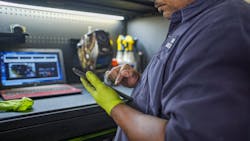This is part one of a two-part article.
Despite all the changes and challenges to the commercial vehicle industry, there’s still one thing that never changes for shops: preventive maintenance. And most importantly, technicians have to do it the right way at the right time. Oil changes, filter cleanings and replacements, tire checks, the list—and the intervals—go on and on.
PMs are the most fundamental part of vehicle maintenance, yet some need reminding of their importance, according to Kevin Clark, head of shop operations for Cox Automotive Mobility Fleet Services.
“A lot of folks forget that it isn’t just checking a box to say it is DOT legal and they changed the oil,” Clark said. “The goal is to identify wear items and safety items on the vehicle that won’t make it to the next PM; it’s to prevent component failures from leaving a driver or load down on the road—or putting them in a safety situation.”
Read more: Trucking's Fountain of Youth: How to keep older assets on the roadDan Carrano, VP of fleet maintenance for A. Duie Pyle, agreed, adding the PM inspection process is all about catching that one part approaching their end of life “before it fails on the road.”
“You want the truck to go from PM to PM with as few failures as possible,” Carrano continued.
Yes, PMs are a bit mundane, and not at all glamorous. After all, who notices when a successful PM is completed? Fleet owners and drivers will notice, however, if the shop missed something that led to a suspension failure or an engine issue. Everyone else who must now spring into action will notice, too.
Scheduling PMs and monitoring that they were done can be a complicated process for maintenance management, especially when dealing with parts and labor shortages. But you can either make excuses or make changes. The maintenance leaders who spoke with Fleet Maintenance on the subject all think change is the better and far more cost-efficient option. And to help all fleets get on the same PM page, they have provided several ways to simplify and optimize this monotonous-yet-critical process.
Coordinating service
The most efficient way to perform PMs is to schedule as many at the same time as possible. That’s easier said than done, though. Many moving parts have to come together to ensure equipment is seen at the appropriate intervals and the right technicians and parts are available.
“The objective is to try and schedule PMs when the driver is off and not going to be driving the truck so it is not affecting their utilization,” said Kirk Altrichter, EVP of fleet services for Kenan Advantage Group.
Clark said a lot of customers prefer Cox Automotive’s mobile service for PMs. “They can leave the vehicle at home and not worry about drivers’ hours; it is more convenient,” he said.
Pyle has established time- and mileage-based PM intervals for its power units and uses a fleet maintenance software system to forecast PM needs based on utilization. Shops get an alert ten days before a truck’s PM is due.
“That 10-day window helps us get those vehicles in and set the priorities,” said Carrano, who added the fleet also regularly reviews PM intervals to ensure the fleet is on target.
Carrano also noted that though equipment manufacturers have been able to extend mileage intervals, that doesn’t mean equipment shouldn’t come into the shop.
“[The interval] changes when you change oil and coolants, but you might [schedule] a dry service and do everything except changing the fluids and the oil filters,” Altrichter said.
Read more: As supply chain problems persist, preventive maintenance is key to TCOInitially, many fleets didn’t realize how extended oil drain intervals would affect equipment, said Daniel Mustafa, director of technical service for TravelCenters of America. “We definitely saw increased failures in those other lubricating components—clutches, U-joints,” he said, adding that the industry saw the trends and adjusted service needs.
Still, over the past five to ten years, TA has seen fewer chances to provide PMs due to extended intervals but is constantly looking for opportunities. TA now offers its base PMs and an extended drain PM that focuses on filters and other components. Shops also provide specialized air disc brake inspections. “They require a minimum of three inspections a year,” Mustafa said.
A. Duie Pyle tracks PM needs with a checklist for each vehicle type and the type of PM, including the annual PM.
There’s one final thing to consider: Before thinking how to sync service the right way, a fleet must first understand the worth of PMs. And to get into an efficient scheduling routine, you might have to spend a little money.
Chris O’Brien, chief operating officer of Fullbay, argued that a strong PM program is an investment.
“Preventive maintenance saves you more money than it costs,” O’Brien asserted. “If someone is shortsighted, they see it as an expense, but that is a disservice to highway safety.”
One option is to invest in fleet maintenance software, such as Fullbay, or one of the several other platforms out there.
The right software will not only ensure companies create a smart maintenance schedule, but also keeps them from bringing equipment in too often, noted Jessica Kim, head of marketing for Pitstop.
“[Routine PMs] can lead to over-maintained vehicles, over repairs, and over costs because it is tied to a static schedule and doesn’t take into account the vehicle’s health,” she said. “You bridge in a maintenance provider like Pitstop, and we pull data from multiple systems.”
Kim added that AI is getting smarter with every data point: “You pull this data together, and it spits out a smart maintenance schedule that fits into the calendar of what you currently have set up.”
Optimizing labor
Once you know what PMs need to be done and when, the next question to answer is who will complete the task?
And finding technicians can be among the top challenges shops face.
“Labor has been an issue for quite a while, not just internally, but externally with the dealerships and repair facilities,” Altrichter said, adding that some techs are more skilled than others and shops may want them on more technical jobs.
Pitstop allows users to create a work order tied to a specific technician. “You can keep track of who is fixing what, so it keeps it automated,” Kim said.
TA has had success hiring dedicated lube technicians who focus on PMs. “Some people choose to stay in those job roles because they are more predictable. We have very long-term lube technicians at many of our locations, but we offer a lot of opportunities for people to grow,” Mustafa said. TA has focused on its recruiting and retention, adding bonuses and vacation benefits for field employees and providing tools to new hires.
“We’re about 5 to 10% up on our technician count,” he said.
The overall challenge is the rapid advancement in technology and maintaining the in-depth knowledge to service vehicles properly, making ongoing training for technicians essential, said Jason Richards, program manager II for TravelCenters of America.
Shops also want to optimize technicians’ time. Fullbay can build PM programs to measure technicians’ efficiency with the expected completion time, O’Brien explained.
“It is very similar to warehousing, where everything is based on a throughput or KPI,” he said. “It is to look for areas where we have them standing around waiting, or doing clerical work rather than maintenance.”
Fullbay’s system can also identify technicians that are underutilized. “Maybe I’m 100% efficient, but I’m standing around waiting for work,” O’Brien said.
To help decrease clerical work in the shop, Trimble says its TMT Fleet Maintenance platform can automatically create “work pending” entries that can be converted to a work order to reduce the amount of manual work needed to sort through and enter data. In TMT, engine fault codes are automatically converted to work pending repairs, and assets are checked whenever an order is opened for PM compliance, work pending, recalls, and warranty status. This increases overall efficiency, said Dave Walters, sales support engineer for Trimble Transportation.
TMT allows shop managers to set dependencies, also known as “nesting” certain repairs together, to create a dynamic schedule that is dependent on when the actual services occur.
“If you have a schedule set up for a chassis lube, an oil change, and a DOT inspection, managers can create dependencies that say ‘after you get the oil change, in a certain number of weeks the next repair will be a chassis lube, and then in another few weeks it’ll be a DOT inspection, and so on and so forth,’” Walters said.

